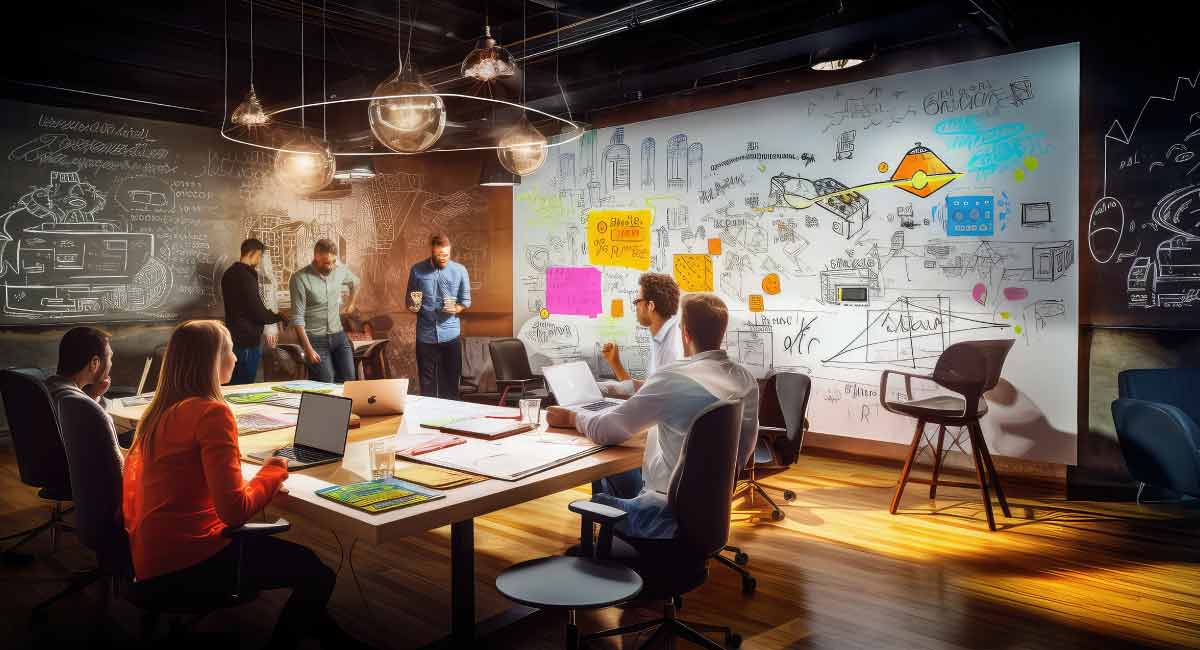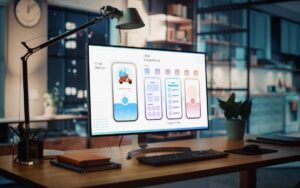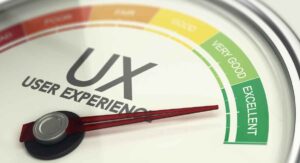Let’s face it: consumers are fussy, picky, and always looking for the next big thing. Furthermore, these traits are all wrapped up in a big bag of short attention spans. So, if a business wants its website or application to be embraced by the public, it must ensure that its product engages the user while delivering functionality. That’s why UI design trends are so important.
This article covers user interface (UI) design trends for 2025. We will start by reminding ourselves what UI is, then show how UI design is changing this year, and then on to the meat of the matter, the top UI trends for 2025. We’ll also share a UX/UI design program professionals can take to boost their careers.
What is a UI?
User interface (or UI for short) is any element of a website, application, or software a user can interact with. UI includes keyboards, screens and touchscreens, sounds, toolbars, sidebars, text, images, and other related elements. The bottom line is that UI is the contact point between human users and a digital asset (computer, mobile device, software, etc.).
So, building off that definition, UI design is the process developers use to build easy-to-use, enjoyable, and functional interfaces for hardware and software.
Also Read: How to Design a User-Friendly Interface?
How UI Design is Changing in 2025
As our digital world continues to produce innovations increasingly rapidly, concepts such as UI design must evolve alongside them. More than ever, customers want user interfaces that are easy to use, visually attractive, and free of complex elements.
Today’s UI designs offer more storytelling with scroll-triggered animations, retro styles, and bolder and wilder typography, and are used in virtual workplaces, mixed reality, and foldable devices.
The Top Ten UI Trends Of 2025
Let’s explore the ten significant user interface design trends of 2025.
- Feature Showcasing on Landing Pages. Designers who want to incorporate a strategic approach to capture the users’ attention immediately create landing pages emphasizing feature showcasing. Landing pages become effective, powerful tools for communicating the highlights of a service or product, using compelling animations, visuals, and concise content. Effective feature showcasing imparts helpful information and guides users through a seamless journey.
- Glassmorphism. Glassmorphism is an eye-catching, attractive design style rising in popularity and will be seen more this year. This compelling style is about making things on the screen resembling frosty glass, and you can see through it. Additionally, glassmorphism employs colorful and bright hues. This style started attracting attention in 2020; even huge companies like Apple and Microsoft are now using it. Designers using glassmorphism in their designs make things on websites or apps appear modern and with a greater degree of depth as if they have extra layers. This style is pleasing to the eye and attracts the viewer’s interest. Designers can also use this design style to call out vital details, such as buttons for the users to press.
- Skeuomorphism. Here’s another “morphism” to digest. Skeuomorphism is a design style using realistic renditions of real-world objects in digital interfaces. Expect a resurgence of skeuomorphism this year, but executed differently than it’s been done previously. This time, expect to see a blend of skeuomorphism and flat design, adding depth to flat screens and helping designers enhance their visual aesthetics.
- Interactive 3D Objects. This year, more designers will incorporate interactive 3D objects into websites and apps. The use of 3D objects is different this year from what it was in previous years since, in the past, it was relegated mainly as a static object set somewhere on the screen. Today, these objects will be meshed into the website’s whole story, creating a seamless and engaging user experience.
- System Themes (Dark/Light). By incorporating system theme dynamics, websites can alter their appearance based on the end user’s system’s theme. This feature provides a seamless, cohesive experience across multiple platforms, aligning the website with the look and feel of the user’s device. System themes allow the website to dynamically adjust as users switch from light to dark modes, providing a personalized touch and visual comfort.
- Flat Design. Flat design is a UI design aesthetic that revolves around simplicity, shifting the interface design paradigm from realistic-looking objects to schematic simplifications of elements. This UI design trend represents a substantial technical advantage, especially for mobile devices, because it allows faster loading speeds. Flat design’s minimalistic approach to UI elements eschews shadows or decorative elements, instead relying heavily on bright colors and the intelligent use of typography to insert character and visual appeal into their designs.
- Voice-Activated UI. Considering the rising use of voice-activated digital assets, the voice-activated user interface is another trend that will dominate UI design this year. We live in the age of Alexa and Siri, with voice commands playing an essential role. So yes, voice-activated UI is here to stay and will become even more popular. Voice-activated UI allows users to interact with speech or voice commands, eliminating the need for a keyboard. The popularity of voice-activated UI is reflected in its numbers. For instance, Statista reports that by the end of 2025, the worldwide number of digital voice assistants will reach an impressive whopping 8.4 billion units, exceeding the global population! Worldwide users embrace this trend because it offers a viable option for people with accessibility issues. Also, since search engine optimization (SEO) has begun exploring voice-based queries, many organizations will turn to voice-activated user interfaces. Thanks to constant technological advancements, word recognition accuracy is steadily improving; thus, its adoption in UI design is also rising.
- Bold Typography. Bold typography, also called rule-breaking typography, is a UI design trend where typography captures the center stage. In this design style, bold typography moves beyond its traditional supportive role and becomes its centerpiece. When typography is the design’s central element, all the rules change; extravagant sizes, spinning, twisting, dividing words into multiple lines, and poor readability are all fair game. However, for designers to successfully bend the principles of typography, it’s essential for them first to understand those very principles. Furthermore, UI designers should make bold choices only if they serve a purpose. Bold typography typically implies a big statement and can have shock value, so it must be thought through and planned deliberately and carefully.
- Minimalism. As the name implies, the minimalist UI trend is based on the Minimalism art movement, whose message can be filtered down to “Less is more.” However, minimalism doesn’t mean an empty, vague design; minimalist interfaces have an elegant and sophisticated visual appeal. Minimalist interfaces emphasize “The More of Less” philosophy, meaning the style uses fewer elements to reduce clutter but gives more attention to the elements that matter most. Minimalist interfaces are simple and elegant and focus on every element’s functionality, the use of negative space, and the addition of bold colors and font combinations. Overall, minimalist UIs are very usable because they lack unnecessary decorative elements, so if they are designed well, the user receives a highly intuitive journey via the design.
- Dark Mode. A dark mode user interface is a design style where light text rests on a dark background. This color scheme lessens the device screen’s luminance, which some studies suggest helps improve visual ergonomics by reducing eye strain. Additionally, UI dark mode also helps conserve battery power somewhat. Dark theme UIs were created as a response to dark-on-light color schemes, which simulate the appearance of dark ink on white paper. However, implementing a dark mode design isn’t about using black and white but instead incorporating a low light and high contrast between the display’s visual elements.
Also Read: A Guide to Improving and Measuring User Experience
Do You Want to Earn a UI/UX Certification?
If you want to gain UI and UX design training, consider this highly effective 20-week UI/UX bootcamp. This online certification course offers Dribble portfolio creation, capstone projects, a designer toolkit, and masterclasses led by industry experts, teaching you how to use popular design tools such as Balsamiq, Figma, Invision, Mural, and Sketch.
UI/UX designers earn an annual average of $87,824, according to Glassdoor.com. Many organizations looking for UI/UX designers want to see a robust set of skills, ideally enhanced through proper certifications. Meet those requirements by signing up for this course and get the skills you need to make your mark on UI design trends in 2025.
FAQ
Q: What are the current trends in UI design?
A: Today’s hot UI design trends include (but are not limited to) 3D and realism, minimalism, dark mode, bold typography, and voice user interface (VUI) design.
Q: What is the future of UI design?
A: Our rapidly changing technology makes it difficult to predict what forms future UI design will take, but there will undoubtedly continue to be a robust need for UI in our digital world.
Q: Is artificial intelligence (AI) taking over UI design?
A: Not likely. UI design involves empathy, creativity, and humancentric thinking, elements that AI can’t imitate. However, AI may be relegated to helping designers with jobs like testing, prototyping, and data analysis.
You might also like to read:
How to Become a UX/UI Designer: A Comprehensive Guide
UX/UI Designer Career Path: A Comprehensive Guide
All About UX/UI Design Principles
Accessibility in UX Design: A Definitive Guide
Career Prep: Linux Interview Questions for UX/UI Design Professionals






